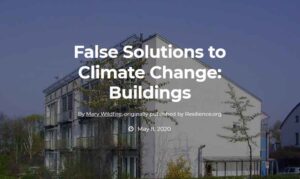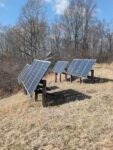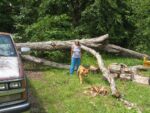- Like
- Digg
- Tumblr
- VKontakte
- Buffer
- Love This
- Odnoklassniki
- Meneame
- Blogger
- Amazon
- Yahoo Mail
- Gmail
- AOL
- Newsvine
- HackerNews
- Evernote
- MySpace
- Mail.ru
- Viadeo
- Line
- Comments
- SMS
- Viber
- Telegram
- Subscribe
- Facebook Messenger
- Kakao
- LiveJournal
- Yammer
- Edgar
- Fintel
- Mix
- Instapaper
- Copy Link
- Bluesky
Originally published on Resilience.org
Editorial Note: This is Part 4 of Mary Wildfire’s series on false solutions to climate change. You can read Part 1 on Electricity here, Part 2 on Transportation here, Part 3 on Agriculture here, Part 5 on Geoengineering here, and Part 6 on Real Solutions here.
It’s become increasingly clear that climate change is not only real but beginning to bite. Now that much of the population is finally feeling the urgency—and during a time when COVID19 has much of our frenetic commerce on hold, giving us a space for thinking and discussion–what can we do to protect the only planet we’ve got? Unfortunately a good many of the solutions on offer seem designed to quiet the increasing concern, the impetus to do something, without challenging the status quo.
Can we get real solutions and still maintain economic growth, population growth, and the growth of inequality? Are we entitled to an ever-rising standard of living? I believe the answer is no; we need some profound transformations if we are to leave our grandchildren a planet that resembles the one we grew up on, rather than a dystopian Hell world. This is the basic theme of the controversial Michael Moore produced film Planet of the Humans. I see that film as seriously flawed, but agree with its basic message—that it’s time for humanity to grow up and accept limits, get over what I call human exceptionalism, or androtheism—the notion that man is God.
A veritable cornucopia of false solutions is being pushed these days, not only by corporations and think tanks but by the UN’s IPCC, the international body responsible for research and action on climate. We could have made a gentle transition if we had begun when we first became aware of this problem decades ago, but for various reasons we did not. There is no time left for barking up one wrong tree after another; no time to waste in false solutions. Hence this series pointing out the fallacies behind such proposals as electrifying everything, carbon trading, geoengineering or switching to “gas—the clean energy fuel!”
I’ve divided the issue into sectors: electricity generation, transportation, agriculture, buildings, and then there are two sections on false solutions that aren’t part of an energy sector—geoengineering schemes, and some other policy options. Finally, we look at real solutions. I am not an expert on anything except maybe gardening, so my hope is to spur discussion.
Part 4: Buildings
Estimations for the percentage of greenhouse gases emitted by the buildings sector vary wildly. But any assessment should include both the embodied energy involved in constructing new buildings and the energy costs of heating, cooling and lighting buildings. Currently, many homes and other buildings require a great deal of electricity for lighting even in daytime, and fossil fuel is often burned for heat and cooling.







There are better ways. Designing a building so that natural daylight takes care of the lighting (in the daytime) simply makes sense. Nowadays there are also solar lighting tubes to convey sunlight into a home without the need for electricity. As for heating, proper design can allow the sun to provide a fair amount of the heat on sunny winter days. Facing the long side of the house toward the south or southeast and putting most of the windows there can enhance winter heating without adding heat in summer; arranging tall trees, or a hill or buildings to the west provides afternoon shade all summer. If the shade comes from deciduous trees or vines, it will open up to the sun in winter.
Passivhauses have become common in Germany, and there are a few even in this country. This is a building so efficient that it doesn’t require central heating—and thus it costs little more to construct than a conventional house, despite the fact that it involves essentially a second set of walls and roof. The details vary geographically, but involve heavy insulation, highly efficient windows, design and siting considerations as mentioned in the paragraph above, the elimination of thermal bridging and the use of a ventilation system that recaptures heat from outgoing air. There are many entire books written on all this, and if you’re building a new house it makes sense to research these matters thoroughly. You’ll save greatly on the economic and environmental costs of heating and cooling that house throughout its life. Also, making a building just big enough to accommodate the needs of its inhabitants, will make a large difference.
Even existing buildings can be made much more efficient through window upgrades, improved insulation, more efficient appliances and lighting, and landscaping to shade the western side especially, as well as landscaping to channel winds to or away from the house. Ruth Foster and Sue Reed have written books just on the landscaping options.
I have not seen a lot of false solutions proffered for this sector, but doing nothing amounts to a false solution, when there is so much we can do to reduce the energy and emissions costs of our buildings.
Teaser photo credit: By Passivhaus Institut – Copied to Commons from Wikipedia. Original source Passivhaus Institut, Germany, CC BY-SA 3.0














